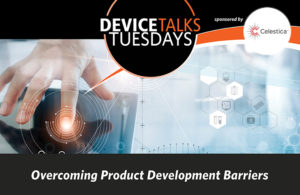Use strategic collaboration to overcome these five common medtech product development challenges.
 Overcoming product-development barriers — the topic of a recent Device Talks Tuesdays webinar sponsored by Celestica — requires the elimination of design silos and the embracement of partnering opportunities. So how does this happen? Kevin Walsh, VP of Celestica’s HealthTech Division, and Kevin McFarlin, engineering director, had some answers.
Overcoming product-development barriers — the topic of a recent Device Talks Tuesdays webinar sponsored by Celestica — requires the elimination of design silos and the embracement of partnering opportunities. So how does this happen? Kevin Walsh, VP of Celestica’s HealthTech Division, and Kevin McFarlin, engineering director, had some answers.
“It’s all about protecting and nurturing a company’s intellectual property in order to get to market as soon as possible,” Walsh said.
As a service provider for OEMs and startups, “we’re looking to mistake-proof the manufacturing and assembly processes,” added McFarlin, who outlined five common product design challenges and strategies for overcoming them.
1. Usability engineering: Establish priorities
Stressing the criticality of a medical device’s ease of use, Walsh emphasized that it is fundamental to widespread adoption and requires product developers to put forth a concerted effort to “design outside a vacuum” to understand the product’s application and use.
“The best way to accomplish this is to conduct usability testing in a simulated environment in which users are observed interacting with the device, often revealing user-interface errors,” McFarlin said. Common user-interface errors include single multifunction buttons, such as an on/off that also dims or brightens the screen, leading to uncertainty in the operating room. Other user-interface errors can include improper use of high-alert colors (red and yellow) for situations not requiring surgeon or physician intervention. In addition, improper handling of print errors can result in popup windows that may cover the patient’s physiological information shown on the screen.
To accomplish usability testing, Walsh advised listeners to consider partnering with a design and manufacturing services provider with ready access to healthcare professionals and observation rooms equipped with two-way mirrors.
2. Early-stage collaboration between design and manufacturing: Start early
Another proactive measure in the product-development process comes from assessing design for manufacturability (DFM). Even when a company has only a computer-aided design model, McFarlin said it’s not too early to engage a design and manufacturing services partner with a thorough knowledge of medical device manufacturing processes to evaluate such things as the efficient orientation of components for assembly. “We can conduct design workshops, and we have specialized software for identifying design considerations,” he said.
3. Independent design reviews: Consider using a manufacturing partner as a reviewer
When left to design products in a vacuum, design teams often focus exclusively on demonstrating the feasibility of the primary functions. The tunnel vision, said McFarlin, may cause them to overlook serious design issues, which is why FDA requires design reviews using independent reviewers with relevant technical experience or education. While McFarlin noted that a design team member can serve as a reviewer, he questioned whether such an individual could be a genuinely independent reviewer. Instead, a service provider acting as a manufacturing partner “could be a good option for countering your group’s bias,” he said.
4. Pre-compliance testing: Test early and often
Once there is an early working prototype, it’s time for pre-compliance testing such as electromagnetic compatibility (EMC). In the case of EMC, the project team needs to measure emissions and evaluate frequencies as it “homes in on offending frequencies,” McFarlin said.
Pre-compliance testing is a great tool, according to McFarlin, who advised its use early and often to ensure the product architecture conforms to safety standards and that there are no electromagnetic compatibility issues. “Fifty percent of devices, McFarlin noted, “will fail EMC testing on the first try,” making the early-and-often mantra even more critical.
5. Eliminate manufacturing challenges by design: Incorporate design techniques for making products easier to test
To achieve the elimination of manufacturing challenges, product developers and their service providers need to strive for comprehensive design for testability to reduce test times while improving manufacturing time so that costs are lower, yields better and time to market faster, concluded McFarlin.
Finally, from a quality perspective, Walsh said, understanding regulations is critical for ensuring that a product remains viable once it goes to market. “Document, document, document,” he proclaimed. “More than 50% of FDA recalls are documentation related. Do your companies have in place the necessary processes for ensuring robust documentation?”
Since 1980, Cleveland-based writer-editor Joe Jancsurak has covered myriad medical, manufacturing and business topics for national publications and organizations.